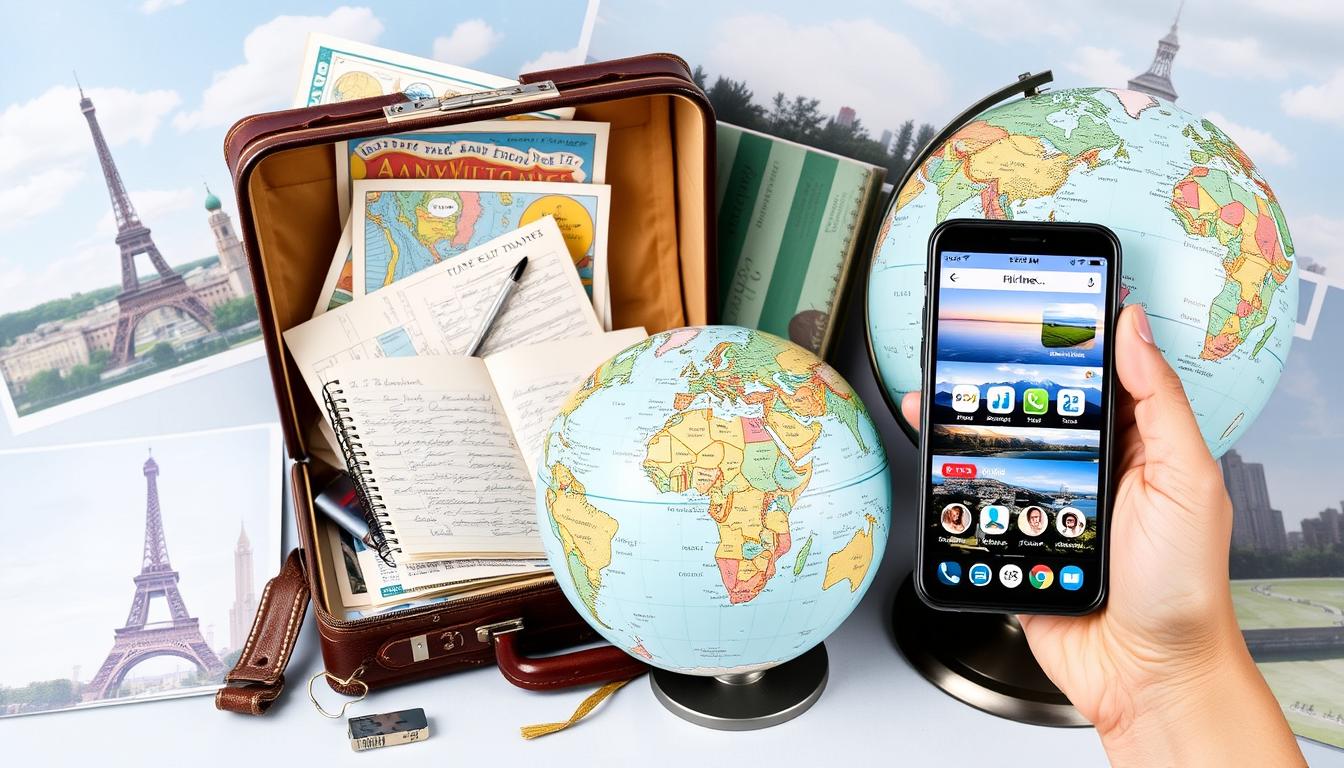Cultural Etiquette Tips for International Travellers: Your Complete Guide to Global Customs
January 26, 2025 | by abdus sekh

More people are traveling internationally than ever before. Knowing cultural etiquette is key to a great trip. It helps you avoid mistakes and connect with locals.
Learning about cultural norms worldwide can seem hard. But, with the right help, you can be a respectful traveler. Knowing how to act in different situations makes your trip better.
By following cultural etiquette tips, you can handle cultural differences well. This is true whether you’re on business or vacation. Knowing local customs makes your trip more enjoyable.
Key Takeaways
- Understanding cultural etiquette when traveling can greatly impact your experience
- Cultural etiquette tips for international travellers can help you avoid unintended offense
- Learning about cultural etiquette around the world is essential to becoming a respectful and savvy globetrotter
- International etiquette plays a vital role in building stronger connections with the local community
- Embracing cultural etiquette when traveling can lead to a more enjoyable and successful trip
- Cultural etiquette around the world is a crucial aspect of international travel that should not be overlooked
- By following cultural etiquette tips for international travellers, you can create lasting memories and navigate cultural differences with ease
Understanding the Importance of Cultural Etiquette While Traveling
Traveling to a new country means learning about local culture and customs. Cultural etiquettes differ greatly from one place to another. For example, in Japan, bowing is a common greeting, unlike in many Western countries where a handshake is usual.
To get around these differences, researching what etiquettes should be followed by anyone while travelling is key. This includes knowing about table manners, dress codes, and social norms. Being culturally aware helps you connect with locals and enjoy your trip more.
Why Cultural Sensitivity Matters
Cultural sensitivity is crucial when exploring a new country. Knowing local customs helps avoid unintentionally offending people. For instance, in many Asian cultures, using chopsticks is common, while in some Middle Eastern and African cultures, eating with the right hand is expected.
The Impact of Cultural Awareness on Travel Experiences
Being culturally aware can greatly improve your travel experience. Understanding what etiquettes should be followed by anyone while travelling lets you handle unfamiliar situations with confidence. This includes knowing about public displays of affection, which are often frowned upon in many Asian countries.
Building Bridges Through Cultural Understanding
Understanding cultures helps build bridges and create positive travel experiences. By researching what are some cultural norms in other countries and respecting local customs, you can connect with locals and make lasting memories. This includes learning about greeting customs, which vary widely across cultures.
Essential Cultural Etiquette Tips for International Travelers
Traveling abroad means being aware of cultural customs abroad to avoid offense. Travel etiquette helps connect different cultures. By respecting local customs, travelers can enjoy their trip more.
Some international travel tips include noticing non-verbal cues. Hand gestures and body language can mean different things in various cultures. For instance, in Japan, bowing shows respect. A slight nod is for casual meetings, while a deeper bow is for formal ones.
Here are some cultural sensitivity tips to remember:
- Respect personal space and physical boundaries
- Avoid touching people’s heads or faces
- Be mindful of dress codes and modesty
By following these travel etiquette tips and embracing different cultures, travelers can have a better experience abroad.
| Country | Cultural Custom |
|---|---|
| Japan | Bowing is a sign of respect |
| Middle East | Modesty is highly valued |
| France | Punctuality is critical in business settings |
Greeting Customs Around the World
Traveling internationally means learning local greeting customs. This helps avoid offense and builds strong relationships. Different cultures have their own ways of greeting, and knowing these is key.
Physical contact and personal space are big in greetings. In some places, a handshake or hug is okay, but in others, it’s not. Also, what you say when you greet someone can mean different things in different cultures.
Physical Contact and Personal Space
In many places, touching is part of saying hello. For example, in France, cheek kissing is common. In Japan, bowing is the traditional way to greet. Knowing these customs helps travelers avoid misunderstandings.
Verbal Greetings and Their Meanings
What you say when you greet someone can vary a lot. In some countries, “hello” is enough, but in others, you need to be more formal. In Japan, for example, there are different greetings for different times of day.
Business Card Exchange Protocols
In business settings, exchanging cards is important. In Japan, cards are given with a bow and received with both hands. Knowing these rules is important for professional greetings.
Respecting local greeting customs is key to making good connections and avoiding offense. Whether it’s a handshake, bow, or words, understanding cultural norms is crucial for a good experience.
| Country | Greeting Custom |
|---|---|
| Japan | Bowing (ojigi) |
| France | Cheek kissing (la bise) |
| India | Namaste (bow and handshake) |
Dining Etiquette Across Different Cultures
Traveling abroad means knowing global travel etiquette to impress others. Dining manners differ greatly from culture to culture. For instance, in Italy, mixing seafood and cheese is seen as impolite. In Thailand, you should move food from fork to spoon before eating it.
Before visiting a new place, it’s smart to learn about international customs advice. In the Middle East, always use your right hand to eat, as the left is considered dirty. In China, leaving a bit of food on your plate shows you’ve been served enough.
Here are some important overseas cultural norms for dining abroad:
- In South Korea, wait for the oldest person to start eating before you do.
- In India, an empty plate means you’re grateful for the meal.
- In Chile, use utensils even for foods like sandwiches or pizza.
Knowing these cultural differences helps you have a respectful dining experience abroad. By following these tips and being aware of global travel etiquette, you’ll make a good impression and enjoy your meals.
| Country | Dining Etiquette |
|---|---|
| Italy | Do not mix seafood and cheese |
| Thailand | Eat with a fork and spoon |
| Middle East | Eat with the right hand only |
| China | Leave a small amount of food on the plate |
Religious and Sacred Site Protocol
Visiting religious and sacred sites requires respect for local customs and traditions. It’s important to dress modestly and remove shoes when needed. Also, remember not to eat or drink in certain areas.
Following cross-cultural manners tips is crucial. For example, in Southeast Asia, avoid pointing your feet at others. Be careful with photography and social media, as some sites may have rules.
- Dress modestly and cover your arms and legs.
- Remove shoes when required.
- Don’t eat or drink in certain areas.
- Be mindful of photography and social media restrictions.
- Respect local customs and traditions.
| Site | Dress Code | Photography |
|---|---|---|
| Muslim sites | Cover arms and legs | Restricted in some areas |
| Buddhist sites | Remove shoes | Allowed, but be respectful |
| Hindu sites | Dress modestly | Restricted in some areas |
By following these guidelines, tourists can have a positive and enriching experience at religious and sacred sites.
Business Meeting Customs in Different Countries
When you’re in a business meeting, cultural etiquette tips for international travellers are key. Knowing the customs of different countries helps build strong business ties. For example, in Japan, being on time is very important. Being late is seen as rude. But in Brazil, it’s more about building relationships than being punctual.
In many places, travel etiquette for different countries is very important in business meetings. In China, people enter a room in order of importance. In India, saying yes to a meal invitation is crucial. In the Middle East and North Africa, building rapport can take time.
Here are some important business meeting customs to remember:
- In Japan, bowing is a common greeting, and exchanging business cards requires both hands and no writing on the card in the giver’s presence.
- In China, Mandarin is the official language, supplemented by Cantonese and Shanghainese.
- In India, vegetarian meals are preferred in business settings, and many Indians refrain from eating pork or beef for religious reasons.

By respecting these customs, international business travellers can make stronger connections and succeed in their work.
| Country | Business Meeting Custom |
|---|---|
| Japan | Bowing and exchanging business cards with both hands |
| China | Entering a room in hierarchical order |
| India | Accepting meal invitations and preferring vegetarian meals |
Gift-Giving Traditions and Taboos
Understanding gift-giving traditions and taboos is key when traveling. Gift-giving shows respect and builds relationships. It’s a big part of international etiquette.
In many places, there are rules for giving and receiving gifts. In East Asia, you might refuse a gift a few times before accepting. In India and the Middle East, use your right hand for gifts, as the left is seen as unclean.
Regional Gift-Giving Differences
Gift-giving customs vary by region. In East Asia, gifts show thanks for hospitality. But, some gifts are unlucky in China and Japan, like umbrellas and clocks.
Also, how you wrap gifts matters. In Asia, avoid white, black, and blue, as they’re for mourning. Yellow is festive in India but bad luck in China. Knowing these customs helps you avoid offense and makes friends.
Body Language and Non-Verbal Communication
When you travel to other countries, knowing what are cultural etiquettes? is key to not offend locals. What are some cultural norms in other countries? can change a lot. For example, eye contact means different things in different places.
A study shows that about 60% of what we communicate is through body language. This makes it very important in meeting people from other cultures. Knowing local customs can make your trip better, as 70% of travelers say.
To do well on what is etiquette for foreign business trips?, learn about local ways before you go. Learning a few words in the local language can help you connect with people, as 80% of travelers find.
Some important things to think about in non-verbal communication are:
- Hand gestures: vary in meaning across cultures
- Facial expressions: can convey different emotions in different cultures
- Personal space: differs significantly across cultures

By paying attention to these non-verbal signs and learning about local customs, you can make your trip better. You’ll also make stronger connections with the people you meet.
| Culture | Eye Contact | Hand Gestures |
|---|---|---|
| Western | Direct, 40-60% of the time | Vary in meaning |
| Japanese | Avoid direct eye contact | Bowing is a common greeting |
| Thai | Intermittent eye contact | Respectful gestures involve the hands together |
Time Perception and Punctuality Across Cultures
Traveling internationally means learning about local time norms and punctuality. It’s important to respect these customs, as they vary greatly. Being on time is key, but what that means can differ a lot.
In the US and Canada, being on time is very important. Being late is seen as rude. But in many Latin American and African countries, time is more flexible. Being a bit late is not always bad.
For instance, in Spain, arriving a bit late is common. It’s seen as part of the culture. This can make punctuality seem out of place.
There are also monochronic and polychronic cultures. Monochronic ones, like in North America, focus on one task at a time. Polychronic cultures, like many in Latin America, value relationships over strict schedules. Knowing these differences helps avoid misunderstandings.
Here are some key differences in time perception and punctuality across cultures:
- Monochronic cultures: US, Canada, Northern Europe
- Polychronic cultures: many Latin American, African, and Asian cultures
- Linear time management: Northern European countries and Anglo-Saxon cultures
- Multi-active approach: Southern Europeans
| Culture | Time Perception | Punctuality |
|---|---|---|
| US | Linear | Highly valued |
| Spain | Flexible | Not strictly adhered to |
| Japan | Linear | Highly valued |
Dress Code Considerations for Global Travelers
When you travel abroad, it’s key to know the local customs and etiquette. Knowing what to do and what not to do can greatly improve your trip. For example, in Saudi Arabia, women must cover their arms, legs, and heads. But tourists can show their face and head.
California Adventure for Toddlers: Complete Guide to Fun Activities
In Uganda, women could face legal trouble for wearing skirts too short. In many Asian countries like South Korea and India, it’s best to wear modest clothes. This means covering your knees to avoid drawing attention.
Respecting local dress codes can make your trip better. 45% of travelers say it leads to better interactions with locals. Also, 80% of travelers find that dressing right makes their interactions with locals more positive.
Here are some important tips for travelers:
- Modest clothing: covering shoulders and knees in countries like Dubai and Italy
- Cultural dress restrictions: avoiding western clothes in some Middle Eastern countries
- Footwear choices: removing shoes in traditional Japanese venues
Being aware of these cultural differences and following local etiquette can make your trip better. Remember, understanding overseas cultural norms helps you avoid trouble and have good interactions with locals.
| Country | Dress Code |
|---|---|
| Saudi Arabia | Cover arms, legs, and heads |
| Uganda | Skirts below the knee |
| Dubai | Modest clothing, cover shoulders and knees |
Conclusion: Embracing Cultural Diversity Through Respectful Travel
As we wrap up this guide on cultural etiquette for travelers, remember the importance of embracing diversity and respecting local customs. By following cross-cultural manners tips, travel etiquette for different countries, and cultural etiquette tips for international travelers, your travels will be smooth and rewarding.
Understanding local greetings, like a firm handshake in the U.S. or a bow in Japan, helps build connections. Respecting cultural dress codes, dining customs, and gift-giving shows your respect for the local way of life.
Learning basic phrases, observing social cues, and talking to locals deepens your appreciation for places. This not only makes your travels more enjoyable but also helps preserve cultural heritage and supports local communities.
Traveling respectfully is a journey that opens your eyes, broadens your views, and creates unforgettable memories. As you explore, remember that the true joy of travel is connecting with the world around you, one thoughtful step at a time.
FAQ
What are cultural etiquettes and why are they important for international travelers?
Cultural etiquette are the unwritten rules that guide behavior in different cultures. It’s key for travelers to respect these customs. This way, they avoid offense, build bridges, and enjoy their travels more.
How can cultural sensitivity and awareness impact my travel experiences?
Cultural sensitivity makes your travels better. It helps you understand local norms, connect with people, and make lasting memories. Embracing diversity and respecting customs enriches your experiences.
What are some essential cultural etiquette tips for international travelers?
Key tips include knowing local greetings, dining manners, and respecting religious sites. Also, be mindful of body language and non-verbal cues. These tips help you navigate cultural differences smoothly.
How do greeting customs vary across different cultures?
Greetings differ a lot, from handshakes to bows. Knowing these customs avoids offense and makes interactions smoother.
What should I know about dining etiquette in different countries?
Dining manners vary, from table settings to utensil use. Respecting local customs enhances your dining experiences.
What are the protocols for visiting religious and sacred sites as an international traveler?
Visiting sacred sites requires knowledge of dress codes and behavior. Respecting these customs ensures a meaningful visit.
How do business meeting customs differ across cultures?
Business meetings vary, from punctuality to communication styles. Knowing these differences helps international business travelers succeed.
What should I know about gift-giving traditions and taboos when traveling internationally?
Gift-giving customs vary, from what to give to when to give. Knowing these traditions avoids offense and ensures your gifts are appreciated.
How can body language and non-verbal communication impact my interactions with locals?
Body language and non-verbal cues have different meanings in cultures. Understanding these helps you communicate better and avoid misunderstandings.
How do perceptions of time and punctuality vary across cultures?
Time perception and punctuality differ between cultures. Knowing these differences helps you manage timing expectations better.
What should I consider when it comes to dress code as an international traveler?
Dress code varies, from modesty to personal style. Dressing respectfully shows respect for local customs and makes a good impression.
Source : Youtube
RELATED POSTS
View all


